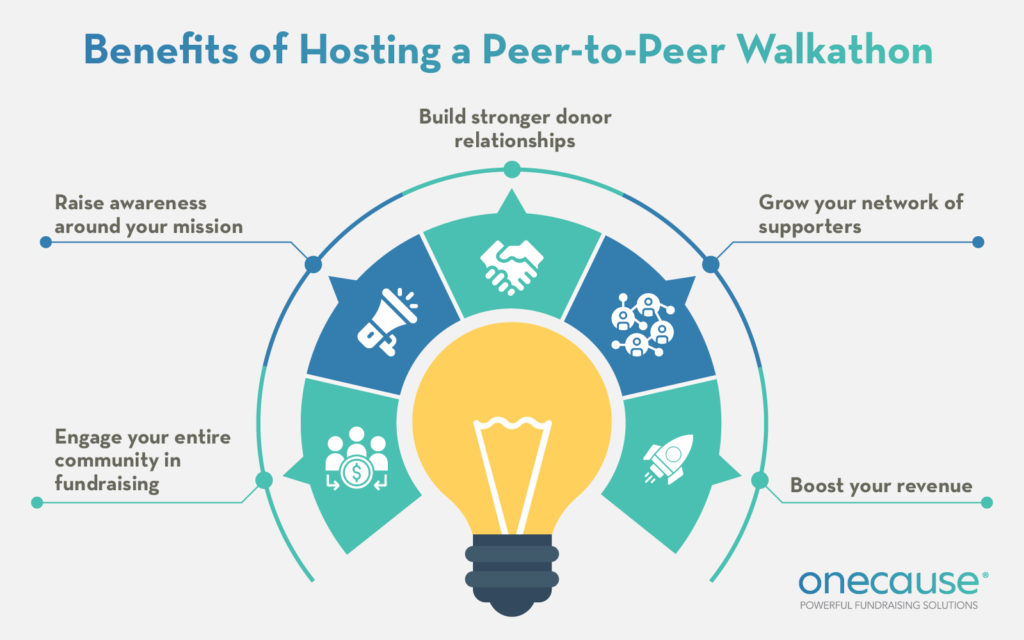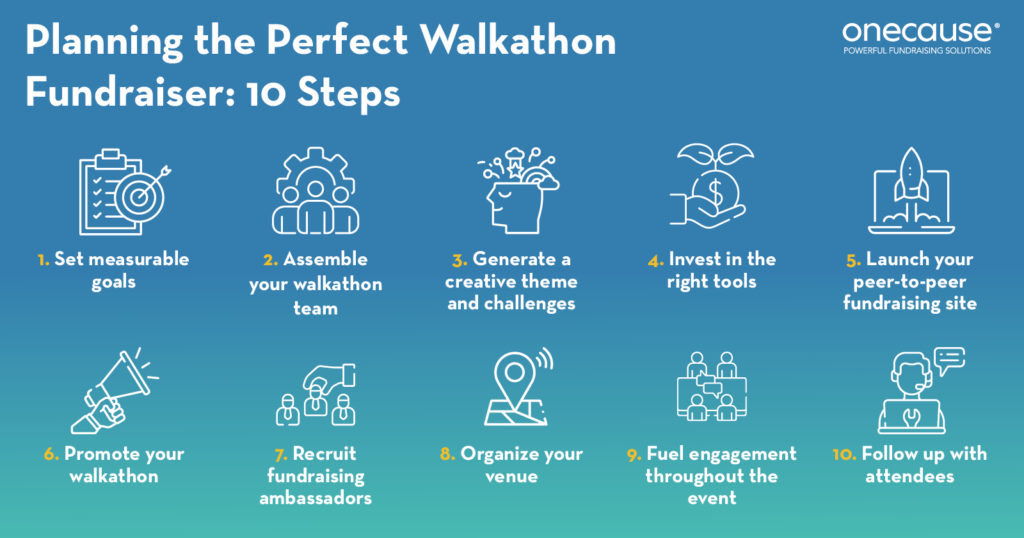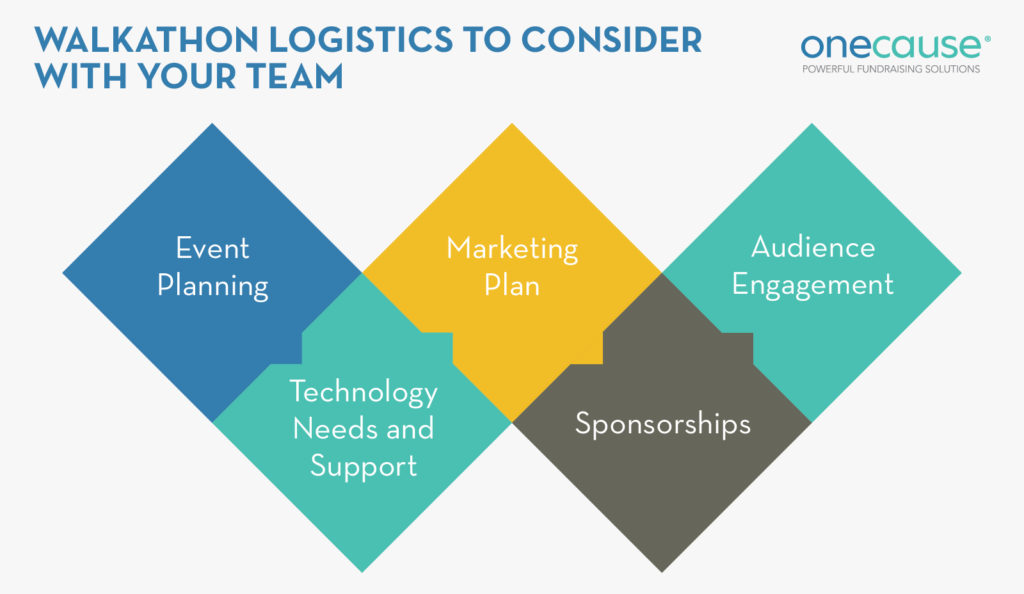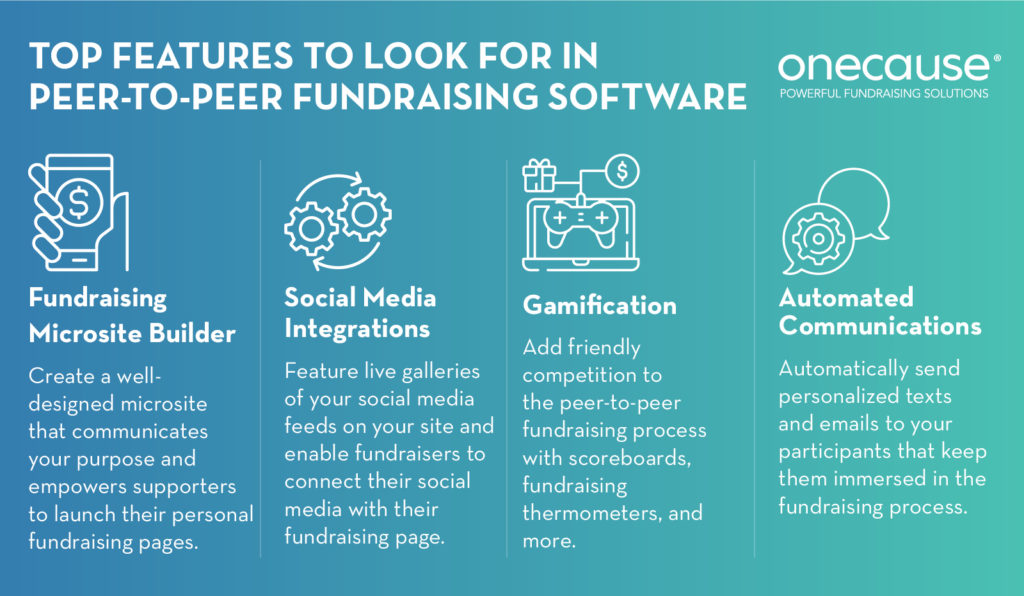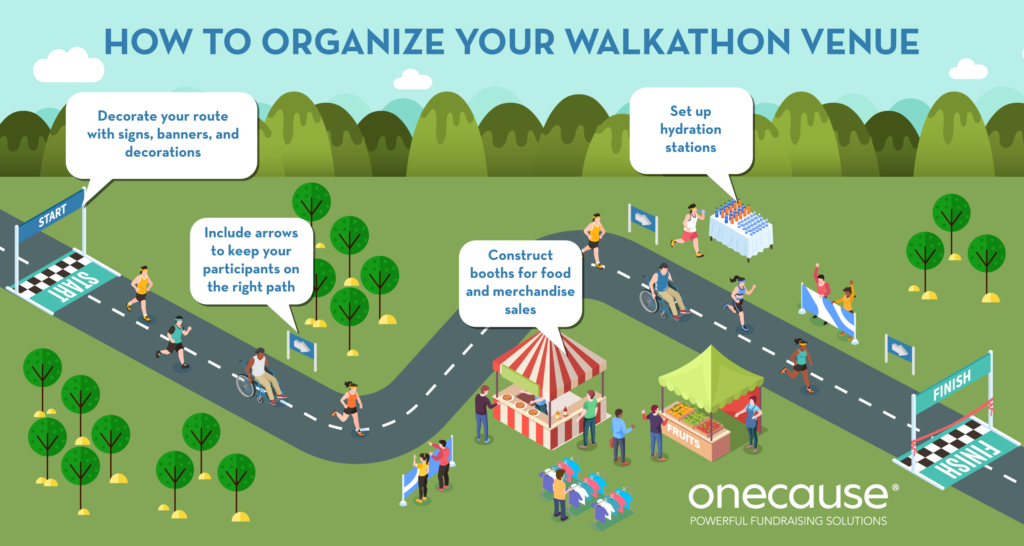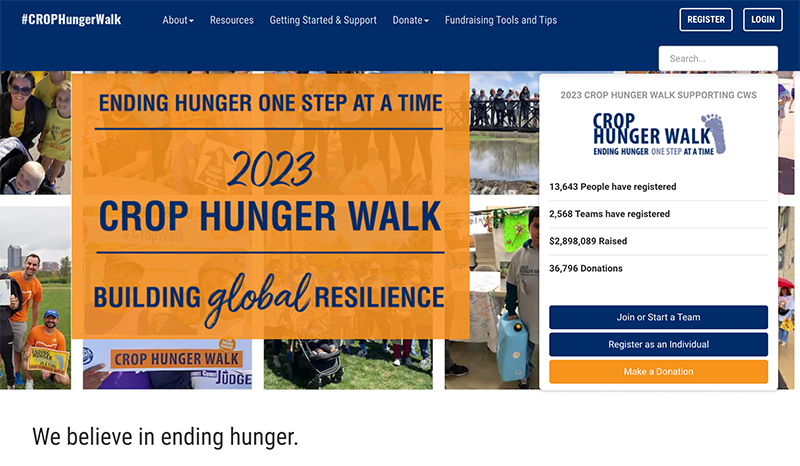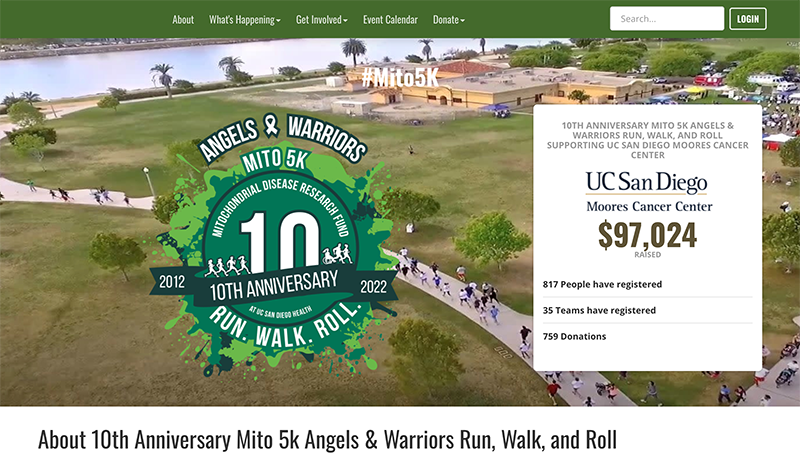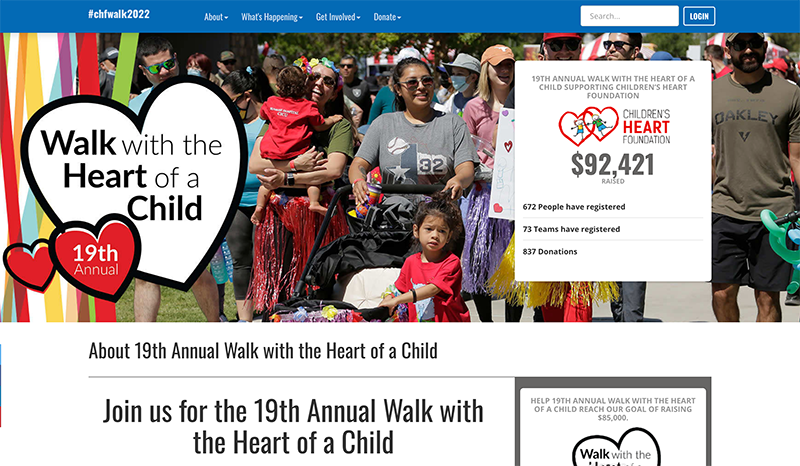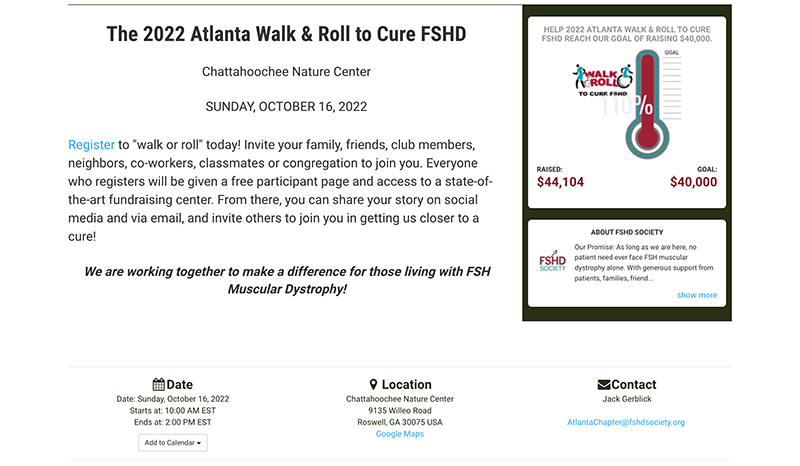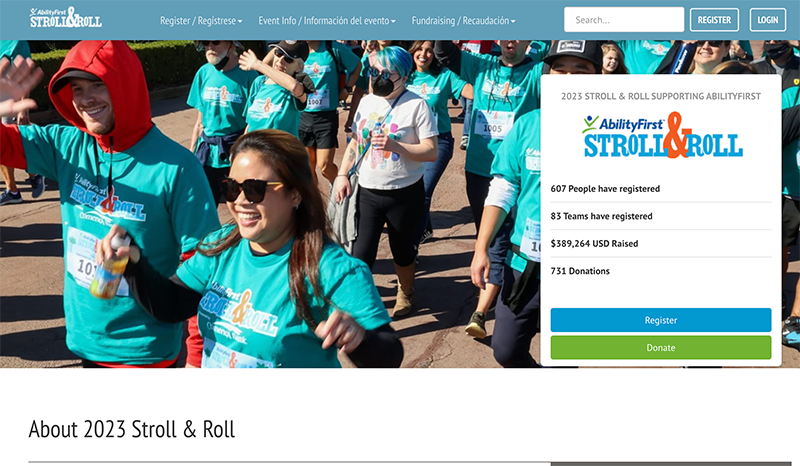From Start to Finish: How to Plan a Walkathon Fundraiser
Whether they’re taking place in your local community or on a larger national scale, walkathons are a staple in the nonprofit sector, and you’ve likely either taken part in one or heard it was happening. These dynamic fundraisers get supporters up and moving for a great cause, pairing the best of both worlds of physical fitness and philanthropy.
But that’s not all! Did you know that donors who participated in runs/walks/rides reported that they were more likely to continue supporting an organization? Not only will you raise some serious funds to go back to your mission with this flexible event, but you’ll also increase donor loyalty and build a sustainable supporter network that you can rely on year after year.
In this guide, we’ll explore everything you need to know to plan your first walkathon fundraiser, including:
- Walkathon Fundraiser FAQs
- How to Plan the Ultimate Walkathon Fundraiser: 10 Steps
- 5 Examples of Inspiring Walkathon Fundraisers
Hosting a walkathon involves a lot of moving parts, but with the right strategies and tools, you’ll be able to streamline the planning process and watch your fundraising results skyrocket in no time. Let’s begin!
Walkathon Fundraiser FAQs
Before we dive into how to host a walkathon, let’s make sure you have the basics down. These common FAQs can get you up to speed on the ins and outs of walkathon fundraising.
What is a walkathon?
A walkathon is a fundraising event in which participants walk a predetermined route in support of your cause. In a traditional walkathon, nonprofits will reserve an outdoor space like the track at a local park or even adjoining roads to accommodate hundreds to thousands of supporters. However, walkathons are inherently flexible, taking place either in-person or online, and can be customized to your nonprofit’s exact needs.
For instance, you might host a hybrid walkathon where your VIP supporters are invited to walk together along a certain path while the rest of your donor base sets distance goals and goes out to complete them anywhere during a set timeframe. Or, you could take the whole walkathon online to save your organization funds and focus on connecting with donors worldwide.
Along with their flexible nature, walkathons are well known for their ability to maximize giving through peer-to-peer fundraising. Typically in a walkathon fundraiser, participants will team up with other individuals to collect funds or create their own personal fundraising pages, asking friends and family members to contribute to their campaigns ahead of the walk.
By handing over the fundraising reins to your loyal supporters, you can effectively grow your reach and earn more donations to meet and surpass your fundraising goals!
What are the benefits of hosting a peer-to-peer walkathon?
As one of the most financially lucrative and engaging events, a walkathon can help your organization:
- Engage your community: Walkathons are inclusive with low barriers to entry, meaning that anyone in your community can get involved. From children to seniors, everyone can benefit from a walk and will feel good taking one knowing that it’s benefiting a great cause. If hosting your event in person, be sure to choose a wheelchair-accessible route to further promote accessibility.
- Build awareness around your mission: Maybe your nonprofit is hoping to use your walkathon to bring attention to a pressing issue in your community or your cause overall. You can easily work in a walkathon as part of a broader awareness campaign to increase public visibility for your mission.
- Strengthen donor relationships: Your donors will play a rewarding role in your walkathon’s success by not only participating but also leading their own peer-to-peer fundraising campaigns. As a result, they’ll feel more connected to the outcome of your event and the success of your organization overall. This will help you solidify stronger donor relationships and retain supporters long after this event is over.
- Expand your network: One of the biggest perks of peer-to-peer fundraising is it helps to increase exposure around your nonprofit and its cause to brand new donors. As friends and family members go to support a participant’s fundraising page, they’ll get to learn more about your organization and might even feel inspired to create their own fundraising page or donate to your nonprofit on a recurring basis in the future.
- Boost revenue: There are many revenue-generation opportunities to choose from to take your walkathon to the next level. From peer-to-peer fundraising to selling branded merchandise at your event to running raffles, you can bake in plenty of extra fundraising moments into your event day. Plus, you can easily plan a walkathon with low overhead costs, allowing you to drive even greater profits.
Whether you want to end your year on a high note with a holiday-themed walkathon or host several walks throughout the year to drum up support, you can make this fundraising event work for your unique needs and goals.
What are the essential elements of a successful walkathon?
To make sure your peer-to-peer walkathon goes off without a hitch, you’ll need the following elements:
- Event planning committee: Gather a dedicated team of staff and volunteers to help pioneer your event and manage the planning and logistics.
- Marketing plan: Supporters can’t participate in your walkathon if they don’t know that it’s happening! A multichannel marketing plan can help you keep your event top of mind and drive impressive registration and donation numbers.
- Accessible venue: Pick a safe and accessible walking route for your fundraiser. Some common venues for walkathons include local parks, school campuses, closed-off streets, and malls if you opt to host your walk indoors.
- Fundraising ambassadors: To get the ball rolling on your peer-to-peer fundraiser, recruit fundraising ambassadors among your board, major donors, loyal volunteers, and corporate connections. Ambassadors are well-connected individuals who can amplify your fundraising efforts to their large networks, helping you acquire new donors and raise even more funds.
- Peer-to-peer fundraising software: Facilitate the seamless creation of personal and team fundraising pages for your supporters with the help of dedicated peer-to-peer fundraising software. The right solution will empower you to create an easily online registration process, launch automated communications to keep supporters engaged, and motivate your fundraisers with gamification.
As you plan out your peer-to-peer walkathon, remember to keep your fundraising goals in mind and tailor the event experience to your audience’s interests. After all, you’ll be much more likely to achieve success if your event keeps supporters actively engaged! Take a deep dive into your target audience’s demographics so you can better inspire them to register, fundraise, walk, and donate.
How to Plan the Ultimate Walkathon Fundraiser: 10 Steps
You already know how important it is to plan in advance, but peer-to-peer events like walkathons require even more logistical support than most events. While it can be tempting to speed through the planning process and leave the finer details to chance, having a strong foundation will prove to be the difference between a 3-star walkathon and a 5-star walkathon.
Follow these steps to construct the ultimate walkathon fundraiser that will inspire participation and donations in large volumes.
1. Set measurable goals
By setting measurable and actionable goals across your team, everything else should fall into place. Think about what you want to achieve with your walkathon, such as reaching a specific goal measured by:
- Number of registrants
- Number of new donors
- Number of returning donors
- Number of peer-to-peer fundraisers
- Total fundraising goal
- Other engagement goals, such as the number of impressions or likes on your social media content related to your event
Peer-to-peer event goals can usually be divided into two buckets: financial and non-financial. Think about the impact of each of these buckets and set clear goals for your event that follow the SMART (specific, measurable, attainable, relevant, and time-bound) model.
Once a goal is set – stick to it. A good starting point here is to look back at past peer-to-peer events your organization has hosted as well as previous walkathons in your community to identify meaningful benchmarks and set new fundraising goals. Your financial goals are easier to achieve when they’re based on past fundraising progress, yet they should be ambitious enough to challenge your team to work hard.
2. Assemble your walkathon team
Planning a well-designed walkathon requires all hands on deck! Assemble a team of staff and volunteers who are passionate about your mission and eager to pull off a dynamic fundraiser in support of your goals. Your team will be tasked with working out your event logistics, including:
- Event planning, including venue set-up and booking vendors
- Technology needs and support
- Marketing campaign
- Sponsorships
- Audience engagement
Your team will also need to set your event budget. Consider all the aspects that will cost your nonprofit money: paying staff, route permits, marketing collateral, peer-to-peer fundraising software, and any other miscellaneous event expenses. If you’re operating on a limited budget, you can always host a virtual walkathon to save funds; just make sure you have the right online fundraising tools to spark engagement!
3. Generate a creative theme and challenges
To spark extra engagement for your walkathon, develop a cohesive theme that ties your event together. This can make your event even more enticing to prospective registrants as you market your peer-to-peer walkathon across platforms like your website, social media, and email newsletters.
For example, if you’re hosting a year-end walkathon, you might challenge your participants to dress up in ugly holiday sweaters or emulate popular holiday figureheads. Or, if it’s Halloween time, you can ask your supporters to wear their costumes and compete for the best-dressed award.
You can even theme your event around your specific cause to further the connection between your fundraiser and your mission. For example, an animal welfare organization might host a dog walk where participants bring their furry friends along for the event.
Once you’ve determined your theme, make your event memorable and unique by adding in activities and contests in the weeks leading up to your walkathon fundraiser. You might challenge your supporters to:
- Compete to raise the most amount of money or acquire the greatest number of new donors with their peer-to-peer campaigns
- Go head-to-head to create the most well-designed peer-to-peer fundraising pages, including visuals and stories about their personal experiences with your nonprofit
- Create unique names for their peer-to-peer teams, awarding the team with the most unique or clever name a special prize
- Share videos on social media of why they’ll be attending your event, attaching a unique event hashtag to the posts and tagging your nonprofit’s social media account to boost your visibility
Don’t be afraid to get creative with your different contests and make sure to factor in your supporters’ interests to bolster participation. It can be worth connecting with loyal supporters ahead of time to check what types of contests or activities would most inspire their involvement.
4. Invest in the right tools
Rather than leveraging a handful of platforms and haphazardly trying to piece them together for smooth data collection, you can streamline the entire event planning and fundraising process with a comprehensive peer-to-peer fundraising solution.
Peer-to-peer fundraising software tailored to run/walk/ride events will make organizing and managing your event a breeze—both for your team and your supporters. Invest in a fundraising platform with the following key features to maximize your success:
Fundraising microsite builder
Your peer-to-peer fundraising site will be the foundational digital hub for your event. Here, supporters can learn more about your walkathon, including how to register and launch their personal fundraising pages. With the right peer-to-peer software, you can develop a modern, flexible microsite design that is 100% authentic to your organization’s branding.
Plus, you can easily embed donation and registration forms right into your site, allowing supporters on mobile or desktop to take action with ease. With 63% of donors reporting that ease of giving is the most important factor when it comes to attending an event, it’s critical that you work with a fundraising solution that will create a user-friendly and simple donation process.
Powerful social media integrations
Your supporters are constantly scrolling through their social media feeds, so why not meet them where they are to spark even more giving? Social media can have far-reaching impacts on the success of your fundraisers; in fact, 32% of online donors expressed that social media is the channel that most inspires them to give.
Adopt social media into your walkathon marketing plan with the help of your peer-to-peer platform. Specifically, your software solution should empower you to feature a live gallery of social media posts right on your microsite, allow participants to automatically connect their social channels to their online accounts, and empower participants to fundraise and invite new walkers and runners directly from social media.
Built-in gamification tools
Everyone loves some friendly competition! Adding gamification to your walkathon fundraiser will help keep engagement levels high, promote peer-to-peer collaboration as teams strive to raise the most amount of revenue, and encourage participants to set and achieve personal fitness goals. Look for peer-to-peer software that offers:
- Leaderboards for fundraising, recruitment, and social sharing
- Milestone badges and emails to recognize participants’ achievements
- Participant dashboard to track progress
- Fundraising thermometers to show overall campaign progress
These elements should be displayed on your peer-to-peer fundraising microsite to amp up excitement and motivate your participants.
Automated communications
When you’re in the thick of event planning, you won’t have time to individually reach out to each support. Instead, leverage fundraising software with automated communications so you can send personalized emails and texts to your participants, volunteers, and donors. From sending thank-you notes to recognizing milestone achievements, your organization can effectively immerse supporters into your walkathon fundraiser and keep it top of mind.
5. Launch your peer-to-peer fundraising site
Your peer-to-peer online fundraising site will be the one-stop shop for anyone who wants to know about your organization or your event. Here, your supporters can take one of two critical actions: registering for your walkathon or contributing a gift (or both!). Let’s take a closer look at how you can design an effective fundraising site that will inspire your supporters to act.
Designing your fundraising site
The content on your fundraising site should be specifically designed to foster emotional connections with supporters and encourage their involvement. Here are some tips to create a compelling design:
- Add visuals, such as photos and videos, of your beneficiaries to show who supporters’ donations will go towards
- Leverage storytelling, such as telling the story of an individual your organization supported, to make the connection between donors’ gifts and the difference it makes even more prominent.
- Prioritize simple navigation by including a navigation bar with straightforward menu titles and call-to-action buttons that direct users to relevant resources, such as your donation page.
- Make sure your donation form (and website as a whole!) is optimized for mobile and streamlined so people can give a gift in just a few moments.
With the right peer-to-peer platform, you can easily develop an engaging microsite that is user-friendly and aligns with your organization’s branding to increase trust.
Developing your content
Here are some critical questions to think about and answer on your microsite so supporters know everything about your event:
- Is this a competitive event or a more casual walk event? Are there any qualifying measures for participants? Will you be having different heats or groups on the day of the event?
- Do participants sign up individually or as a group? Can parents sign up their children on the same form?
- How do supporters create their peer-to-peer fundraising pages to share with their personal networks?
- How much is registration? Can participants donate extra outside of their registration fee? What about donating without participating in the walk?
- How will you recognize your corporate sponsors on your microsite? Will you include sponsor logos on your site to support their marketing goals?
- Will there be merchandise for sale? Can supporters buy this on your site or only in person during the event?
Provide the answers to these questions as well as a broad overview of your walkathon—including your purpose and your fundraising goal—so supporters know exactly how this fundraiser will benefit the community and how they can participate.
Planning engagement and motivation
One of the elements that makes peer-to-peer events stand out from their counterparts is ongoing engagement and competition. By challenging their friends, family, and social networks, participants can increase donations and raise brand awareness for your organization. For best results, add leveraging the following engagement modules on your website and gamification tools:
- Leaderboards to recognize and reward individuals and teams in different categories (such as fundraising, social sharing, and recruiting).
- Triggered emails to send encouraging updates that keep participants engaged.
- Badges that highlight participant achievement in fundraising and overall involvement, such as “Stellar Fundraiser” or “Warrior Walker.”
- Galleries and social feeds that pull in all of the photos, videos, and social posts being shared
Once you’ve got your fundraising site set up, take it live, but don’t start promoting your walkathon quite yet. Send your link to a few trusted donors or board members for feedback. Have them engage with the social links, see if the interactive elements are working correctly, and check if your content leaves any questions unanswered and can be improved.
6. Promote your walkathon
A strong marketing plan for your event can help you effectively create buzz around your walkathon, expand your reach, and ensure you meet your fundraising goals. Check out how you can promote your event via outbound campaigns, social media, and your peer-to-peer fundraising site.
Outbound campaigns
Outbound campaigns include traditional email promotions, digital ads, flyers, direct mail, and more. Any print collateral that you would hang up in, let’s say, in a running store or gym, also constitutes an outbound campaign.
These types of campaigns are great for walkathons because they can promote your event to different groups of people who would be eager to get up and moving for a great cause. It’s your responsibility to hook them with your messaging and turn them into a repeat donor, so clearly articulate your event’s purpose and create a strong call to action to sign up in your materials.
Social media
Generate a variety of engaging social media content related to your walkathon, such as photos of volunteers hard at work setting up your event or video testimonials from your staff explaining why supporters should participate. Your team should start sharing walkathon content at least a month in advance of the event day so your community can mark it on their calendars and begin peer-to-peer fundraising.
To expand your digital reach, consider using a popular hashtag related to your cause. For instance, an animal welfare organization might attach the hashtag #AdoptDontShop to their posts to catch the interest of animal enthusiasts who fall under their target audience. You should also generate a unique event hashtag with your organization name to boost visibility, and make sure all of your supporters use this hashtag when sharing content about your event.
Eager to take your social media strategy to the next level? Connect with influencers in your community to spread the word about your event! We’ll provide more information on how to cultivate and leverage influencer connections in the next step.
Peer-to-peer engagement
If your peer-to-peer online fundraising site was set up correctly, your participants should be able to easily create their own fundraising pages, share their progress, and engage their networks to work towards a fundraising goal. Create all of the necessary content on your webpage so participants can quickly set up their personal page and leverage social sharing buttons to invite others to join and donate.
7. Recruit fundraising ambassadors
To get the ball rolling on your fundraiser, your nonprofit should set up an ambassador program. Ambassadors are the social butterflies of the fundraising world, leveraging their vast networks to increase exposure for your organization and event. Plus, by creating their own peer-to-peer fundraising pages, they can generate a ton of revenue for your nonprofit!
Recruit fundraising ambassadors among your:
- Board members
- Major donors
- Staff and volunteers
- Event committee members
- Supporters with large social media followings
- Sponsors and local business connections
Once you’ve identified individuals who would be the right fit for your ambassador program and expressed interest, set them up for success by training them in peer-to-peer fundraising best practices. Specifically, go over how to create a personal fundraising page and share it on social media, and cover your brand guidelines so they can represent your organization accurately online.
8. Organize your venue
If you’re hosting a traditional in-person walkathon, you’ll need to make sure your venue is all ready to go before the event day rolls around! Assemble your event committee and stellar squad of volunteers to help put all the pieces into place for a smooth event day, including:
- Organizing check-in stations for your participants
- Setting up clear signs and arrows for the walking path
- Decorating the route with banners and posters
- Designing a central stage or area for opening speeches and announcements
- Creating a lost-and-found booth for any items dropped along the way
- Constructing booths for food or merchandise sales
- Setting up hydration stations at multiple points on the walking route
Make sure to coordinate with security officials to maximize safety and secure all necessary permits so your event can go off without a hitch! You should also have all participants fill out event waivers in advance so your organization won’t be liable for any injuries incurred. Using your peer-to-peer platform, you can send out automated reminders to your participants to get these in before the walk.
9. Fuel engagement throughout the event
Your walkathon has just kicked off, so to keep engagement levels high, you need a couple of concrete strategies on hand. Let’s go over how you can motivate your participants to make it to the finish line and participate in extra fundraising opportunities to boost giving:
- Welcome all participants with an opening speech that thanks them for peer-to-peer fundraising and attending your event. Report on how much money you’ve raised so far and explain the impact of these donations.
- Encourage attendees to post a photo or video of themselves on their walk with your unique event hashtag. Repost the best content to your story and award winners with prizes!
- Ask volunteers to stand along the walking route to cheer on participants. There should also be a good group of people waiting at the finish line to applaud and give a big high five to participants as they conclude the walk.
- Set up information booths or tents along the walk where participants can pause for a break and learn more about your cause. You might also set up a station by the finish line where supporters can purchase branded tees or snacks, with all the proceeds going back to your nonprofit.
- Display a fundraising thermometer at your event venue that shows how close you are to hitting your goals. This can help to fuel some extra gifts before your walkathon comes to a close.
The event isn’t over when the last participant crosses the finish line! Punctuate your event with a celebration ceremony. Your emcee should announce the winners of your various contests, including the fundraising team or individual who raised the most amount of revenue, recruited the greatest number of participants, and acquired the most new donors. Consider distributing fun prizes like medals or merchandise to thank them for all their hard work.
By making the walkathon experience as rewarding and exciting as possible for your participants, you’ll be more likely to retain their support for future events and campaigns. This is also true for your virtual peer-to-peer walkathons, so incorporate gamification and social media contests to keep your remote attendees in the moment.
10. Follow up with attendees
The follow-up stage is a critical part of any fundraising event, but it’s especially important for walkathons since you might have participants from the community who are brand new to your organization. To build strong relationships with new and existing supporters, keep these tips in mind:
- Express heartfelt gratitude to everyone involved in your event, including participants, sponsors, donors, special guests, and volunteers. This will make your community feel as though they have a special, personal relationship with your organization, and will bring people back for future events. Leverage your peer-to-peer software to power off automated emails and texts expressing your thanks.
- Report on how much you raised and whether you reached your goal. You can continue to accept donations on your peer-to-peer site, but change the messaging to thank people for attending and get them ready for the next event.
- Send out a survey to assess how well your event was received. You can ask participants about the course, the registration process, the peer-to-peer fundraising experience, the awards ceremony, and more. These insights will direct you to ways you can improve your events for even greater engagement.
While the primary focus of your post-event follow-up should be on thanking supporters, it doesn’t hurt to mention different ways they can stay involved in your organization. For instance, you might invite supporters to follow you on social media, sign up for your email newsletter, or apply to volunteer. This way, you can turn casual participants into loyal advocates of your cause!
5 Examples of Inspiring Walkathon Fundraisers
Although walkathons all have the same underlying structure, your nonprofit can incorporate a mix of different ideas to step up your engagement. Let’s take a look at some successful walkathons to help you gather inspiration for your next event.
1. Church World Service: Crop Hunger Walk
Church World Service (CWS) was founded to help communities across the globe receive basic needs like food and shelter. When the war in Ukraine caused devastating humanitarian effects and food insecurity worsened, CWS needed a way to raise funds fast in support of Ukrainian families. To rally the world around this cause, CWS hosted a peer-to-peer walkathon called the Crop Hunger Walk in multiple locations around the United States.
Donors were encouraged to rally a team of friends and family members together and sign up, with an interactive map available for them on the fundraising site to find the nearest Crop Hunger Walk. The result? CWS raised nearly $3 million among 13,641 individual participants and 2,568 teams with the help of OneCause peer-to-peer fundraising software. This impressive case study shows the power of peer-to-peer fundraising in growing your network and leveraging supporters’ connections for even greater fundraising results.
And, if you’re a national or international organization with a big following, you can host walkathons in multiple locations just like Church World Service to engage the most amount of people in fundraising. Just make sure you have enough room in your budget to tackle a project like this!
2. UC San Diego Moores Cancer Center: Mito 5k
As a leader in cancer research and care, UC San Diego Moores Cancer Center is dedicated to saving lives. One of the ways they meet their mission is by hosting fundraising events, including high-energy walkathons, to spread awareness and raise lifesaving funds to find treatments and cures. Among these events, their annual “Mito 5k Angels & Warriors: Run, Walk, and Roll” stands out as a great walkathon example for nonprofits to emulate.
On the 10th anniversary of this dynamic peer-to-peer fundraiser, UC San Diego raised $97,024 to go towards patients currently battling mitochondrial disease and research. How did they do it? With comprehensive software and engagement strategies! Powered by OneCause, UC San Diego designed a strong peer-to-peer fundraising site that tells the story of their mission and event, effectively encouraging people to register and donate.
Plus, they had something for everyone in their diverse program agenda beyond the walk, from food trucks to carnival games. This is a great idea for nonprofits looking for extra revenue-generating opportunities to meet and surpass their goals.
3. Children’s Heart Foundation: Heart of a Child Walk
The Children’s Heart Foundation seeks to support children born with congenital heart disease in the United States. As part of their mission to “save little hearts,” this organization hosts an annual walkathon, named the Walk with the Heart of a Child, at a regional park so families from neighboring communities can come together in support of this amazing cause.
For their 19th annual walk, the Children’s Heart Foundation set out to raise $85,000. Not only did they meet this goal, but they exceeded it by raising a total of $92,421! This success was driven strongly by their peer-to-peer fundraising site created with the help of OneCause, which used high-impact visuals from their previous walks and prominently featured their branding, helping to establish donor trust and spark engagement.
The Children’s Heart Foundation also displayed social proof to encourage participation. On the microsite, site visitors can see how many people signed up to fundraise and even look up names to check if someone they know has joined. Including social proof like this module creates a “fear of missing out” and inspires even more giving!
4. The FSHD Society: Atlanta Walk & Roll
The FSHD Society works towards supporting and empowering families affected by Facioscapulohumeral Muscular Dystrophy (FSHD). To help accelerate this mission and their pursuit of a cure, the FSHD society hosts an annual “Atlanta Walk and Roll” fundraiser, inviting community members, friends, and family to create team fundraising pages and come together for an exciting walkathon.
With the OneCause peer-to-peer fundraising software, the FSHD Society raised $44,104, surpassing their goal of $40,000! To achieve these results, the FSHD Society featured their story and gamification tools like a fundraising thermometer right on their fundraising site, helping to create a sense of immediacy and encourage people to give as much as possible.
What else made this walkathon stand out? Its focus on inclusivity! By making the name of this fundraiser “Atlanta Walk & Roll” instead of just “Atlanta Walk,” the FSHD society made it clear that individuals of all abilities were invited and welcome to join. Factoring inclusivity into your event planning and name can help you attract more support for your upcoming walkathon.
5. AbilityFirst: Stroll & Roll
AbilityFirst aims to create a space where people of all abilities feel like they belong and can achieve their full potential. This purpose is evident in everything they do, from their targeted programming to support the transition from childhood to adult life to the annual fundraising events they host, including the Stroll & Roll.
Hosted every year, the Stroll & Roll invites the beneficiaries they serve and their families to register, peer-to-peer fundraise, volunteer, or share their fundraising site powered by OneCause on social media. The result? AbilityFirst raised $388,104 from 83 fundraising teams!
Their well-designed peer-to-peer fundraising microsite had a huge impact on their success. As soon as site visitors land on their page, they are met with a dynamic video featuring testimonials from supporters about why they’re participating.
Plus, their microsite breaks down how donations will be used and even highlights a “Walk Kit” that will come with the registration fee, including a branded tee, medal, and racing bibs. This shows the importance of highlighting event perks to entice supporters and infusing transparency into your mission to build trust with donors!
Wrapping Up
If your nonprofit is looking for a way to step up your fundraising strategy and rally the community around your case, a walkathon could be just what you need. Peer-to-peer walkathons help your supporters play a more rewarding and active role in your nonprofit’s mission, allowing you to build stronger relationships and welcome new donors to your cause. Use these essential strategies to put together a winning walkathon that will put your organization on the map!
Eager for more tips and tricks on designing an impactful walkathon? Explore these additional resources:
- 16 Tips to Rock Your Next Run, Walk, or Ride: Whether you’re hosting a walk, run, or ride event, you need a strong fundraising plan. Check out these top tips to maximize your success.
- The Nonprofit’s Guide to Peer-to-Peer Ambassador Fundraising: Your walkathon isn’t complete without the help of well-connected ambassadors! See how you can recruit, train, and motivate fundraising ambassadors to help with peer-to-peer fundraising.
- Top 12+ Nonprofit Fundraising Platforms to Explore: An all-in-one fundraising platform can support your nonprofit in leading a variety of engaging events and campaigns in addition to a walkathon. Check out our roundup of the top fundraising software.

